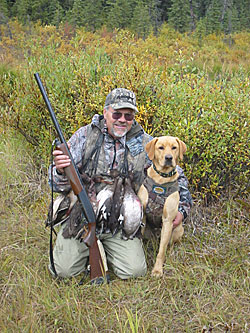Waterfowl Hunting in Alaska
 Migratory bird hunters in Alaska have numerous opportunities to harvest waterfowl, sandhill cranes, and snipe. Whether decoying brant over eel grass beds at Cold Bay, jump-shooting dabblers on Minto Flats, or waiting in a pit blind for a crack at speckle bellies in Delta, the variety of bird species hunted and the diversity of hunting venues are unique to the state. Alaska's marine and freshwater wetlands produce a fall flight of about 12 million ducks and over one million geese to all four North American flyways and neighboring countries. They also provide vital staging habitat for migrants that breed in Canada and Russia. Approximately 8,800 waterfowl hunters in Alaska can expect to harvest close to 70,000 ducks and 7,000 geese per hunting season.
Migratory bird hunters in Alaska have numerous opportunities to harvest waterfowl, sandhill cranes, and snipe. Whether decoying brant over eel grass beds at Cold Bay, jump-shooting dabblers on Minto Flats, or waiting in a pit blind for a crack at speckle bellies in Delta, the variety of bird species hunted and the diversity of hunting venues are unique to the state. Alaska's marine and freshwater wetlands produce a fall flight of about 12 million ducks and over one million geese to all four North American flyways and neighboring countries. They also provide vital staging habitat for migrants that breed in Canada and Russia. Approximately 8,800 waterfowl hunters in Alaska can expect to harvest close to 70,000 ducks and 7,000 geese per hunting season.
The annual process for setting migratory bird hunting regulations begins in January and ends in September. For management and regulations purposes, Alaska has 26 game management units which are divided into 5 migratory bird hunting zones. The first thing to do before going afield is to determine what game management unit you are going to be hunting in and then find its correlating zone. Become familiar with the regulations and shooting times for that zone, and purchase appropriate stamps and licenses. Special permits may be required to hunt certain species (e.g., swans), or in particular areas (e.g., Anchorage Coastal Wildlife Refuge). Be aware of special restrictions and legal methods of take. Remember that nontoxic shot is required for hunting waterfowl, sandhill cranes, and snipe; you cannot carry lead shot in the field while hunting migratory birds. Also, know the federal regulations regarding transport and shipping, possession and tagging, and additional methods of take. All of these are outlined in the Alaska Migratory Bird Hunting Regulations. For complete federal hunting rules, contact the U.S. Fish and Wildlife Service (USFWS), Law Enforcement, 1011 E. Tudor Road, Anchorage, AK 99503, phone (907) 786-3311. Dog trainers and hunting dog clubs should be aware of the regulations for using birds for training purposes.
If you are new to the state or a non-resident, you may feel that hiring a Migratory Bird Hunting Guide (PDF 89 kB) would be a good way to go. Sea duck hunters may wish to visit the Sea Duck Joint Venture website to learn about sea duck biology and management throughout North America. Goose hunters may wish to visit the Arctic Goose Joint Venture website to learn about the current status of goose populations.
Migratory birds are often banded or collared for scientific studies. They are legal game. However, if you take a marked animal, you must notify either the Alaska Department of Fish and Game, or the USFWS. Reporting a bird band is easy and informative. Bird bands furnish valuable data on the origin, movements and ages of ducks and geese. You may keep the bands and you will receive a certificate noting the date and location each bird was originally banded.
Waterfowl hunting requires more gear than almost any other type of hunting. A little pre-season preparation can prevent a frustrating opening day: Touch up those decoys and rig them for the type of water body you'll be hunting. Inspect and test your boat and motor well before heading out to the field. Shooting several rounds of trap or skeet will sharpen your skills and, especially when combined with using a well trained retriever, will reduce your crippling loss. Above all else know your birds. Shooting a non-target or illegal species is not only embarrassing, but it may also lead to fines, and loss of equipment and hunting privileges.
